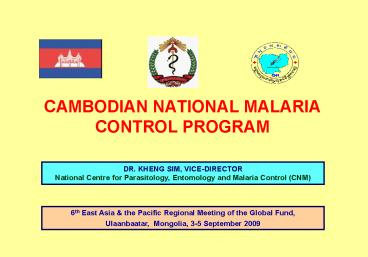CAMBODIAN NATIONAL MALARIA CONTROL PROGRAM - PowerPoint PPT Presentation
1 / 29
Title: CAMBODIAN NATIONAL MALARIA CONTROL PROGRAM
1
CAMBODIAN NATIONAL MALARIA CONTROL PROGRAM
2
OUTLINE OF PRESENTATION
- Burden of Malaria
- National Malaria Control Program (NMCP)
- Contribution made by GF Grants to National
Targets - Obstacles and challenges faced
- Innovative Interventions
- Bottleneck
- Partners
- Future Perspective
3
Malaria Disease Burden in Cambodia
4
Average 9.7 annual reduction of (reported)
malaria cases since 2004.
5
(No Transcript)
6
Malaria Disease Burden in Cambodia (contd.)
Transmission is high and seasonal being
associated with the rainy season
7
Malaria Disease Burden in Cambodia (contd.)
8
(No Transcript)
9
(No Transcript)
10
Organizational structure of NMCP (Public Sector)
The National Malaria Control Program is a
vertical program led by CNM, but it is
decentralized administratively with
responsibilities for activities assigned to
provincial and district health departments.
11
Functions decentralized by CNM
12
Goal Reduction of malaria mortality by 50 in
2014 and malaria morbidity at least by 30 in
2014 (consistent with the Round 2 overarching
goals)
- Strategies
- Strategy 1 Improving access to preventive
measures (LLINs and LLIHNs) that protect the
population at risk - Strategy 2 Increasing access to early diagnosis
and treatment (EDAT) for malaria throughout the
country by scaling up the VMW project approach. - Strategy 3 Increasing community awareness and
improving care-taking practices on malaria
prevention and control with promotion of proper
health seeking behavior in malaria endemic areas.
- Strategy 4 Strengthening the institutional
capacity of the national malaria control program
at all levels.
13
CONTRIBUTION OF GF GRANTs TO NATIONAL MALARIA
PROJECTS
14
15
(No Transcript)
16
(No Transcript)
17
Obstacles/challenges faced by NMCP
- Widely availability of counterfeit/ substandard
drugs in the private sector - Irrational use of anti malarial- especially in
the private sector - Emergence of Artemisinin resistance especially in
the Cambodia- Thailand - Reach to mobile and migrant populations and other
vulnerable populations in remote areas
18
History of Drug Resistance
- Drug resistant malaria parasites have frequently
emerged from the border area between Cambodia and
Thailand. - It started in the 1970s with resistance to
chloroquine, followed by sulfadoxine-pyrimethamine
, and then mefloquine. - There is recent evidence of increasing parasite
clearance times to the current nationally
recommended artemisinin-combination therapy
(ACT). This may signal the beginning of drug
resistance to artemisinin-derivatives.
19
Proportion with treatment failure of Artesunate
Mefloquine, Coartem (2001-2007)
20
PCT in Pailin study 2007 (n40)
21
Innovative Intervention
- Implementation of an innovative short term
project to contain artemisinin resistant
parasites - Enhancement of banning monotherapy nationwide
- Scaling up the VMW strategy to accelerate the
EDAT at the community level - Development of private sector strategy
- Piloting Public- Private Mix Strategy
- Proposal submitted on piloting AMFm strategy
22
Containment Project
The containment implementation area includes 10
provinces in Cambodia along the border with
Thailand.
23
Targeted populations in Zones 1 and 2
24
Program Policies Strategies
- Diagnosis use of combo-RDTs at public health
centers and by - VMWs. Microscopy at former district
hospitals Referral Hospitals. - Social Marketing of Malacheck combo-RDTs in
the Private sector - through PSI
- Treatment ACT at public health facilities
(DHAPiperaquine in - Zone 1 and AM in the rest of the country)
and through VMWs . - Zone 1 Ban of sale of monotherapy in the
private sector. - Rest of the country Malarine social
marketing through PSI. - Vector Control Public sector LLINs and LLIHNs
in villages within - 2km of the forest plus retreatment of
existing conventional nets. - Focal IRS in containment zones.
- Private Sector Bundling strategy (treatment
of bed - nets imported/distributed) by PSI
25
Program Policies and Strategies (contd.)
- IEC Combination of mass media (TV, Radio, Video
and audio - spots), group education (through VHVs) and
interpersonal - communication (through health staff at health
facilities). Special - emphasis on training of school teachers
health - education of school students.
- ME Efficient use of HIS and strengthening of
malaria - information system and surveillance.
Computerization of - malaria information at central, provincial
and OD level. - Private Sector Cooperation Mainly mobilized
through NGOs. - Involvement of private importers
distributors proposed (AMFm) - Capacity Development/training Health staff
involved in - treatment and prevention of malaria motivated
through a wide - range of training, supervision, mentoring
facilitating - working environment as well as financial
incentives.
26
ACT Bottleneck Looking forward
- Due to changes in Global Fund Q/A Guidelines, the
current co-blistered ASMQ will no longer be
eligible for repackaging at Cipla. - The national program would like to switch from a
co-blistered to co -formulated ACT. - Currently, there is not another WHO Prequalified
drug that is efficacious in Cambodia. - The national program has applied for the first
phase of the Affordable Medicines
Facility-malaria (AMFm), which is expected to
start in mid-2010. - Problems in procuring artesunate suppositories
- According the national treatment guidelines,
artesunate suppositories to be used as the
pre-referral treatment of severe malaria (this is
in the line of WHO malaria treatment guidelines)
27
Future Perspective
28
Major Donors Partners of NMCP
- Health Unlimited
- Implementing NGO in 2 provinces (GF R4, R6 RCC)
- Partners for Development
- Implementing NGO in 2 provinces (GF R4, R6 RCC)
- URC
- - Training for QA
- NIH
- Research
- PSI Cambodia
- Social marketing of Malarine and Malacheck
- FHI
- Implementing NGO
- GFATM
- R4, R6 R2 RCC Grants
- USAID Cambodia
- Donates to CNM through the WHO (mainly drug
resistance) - WHO
- Technical assistance
- HSSP (WB/ADB/DFID)
- Strengthening PH Systems
- BMGF
- -Containment of Artemisinin resistance
- Pasteur Institute
- Research
29
THANK YOU!

